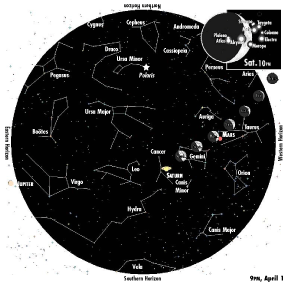Pop Go the Pleiades
Lunar occultation of Seven Sisters a sight to behold
Friday’s nascent moon appears as a thin crescent above the western horizon at sunset at 6:30 and sets in the northwest not three hours later. Sunset Saturday finds the crescent moon higher in the sky in the company of the Pleiades. Before the moon sets, it will pass over each of the seven sisters of this easy to spot cluster. Conditions allowing and patience enduring, you can watch the entire preceding with your unaided eyes. But binoculars or, better yet, a telescope will make this a more dazzling sight.
Looking at the moon you’ll notice two parts: the bright crescent, illuminated by sunlight reflecting off the lunar surface; and a greyish, dimly illuminated section that completes the moon’s round shape. Called earthshine, this is a result of sunlight from earth’s day-lit face reflected back against the moon’s darkened section and should not be confused with the dark side of the moon, which cannot be seen from earth.
As darkness settles, sharp eyes will reveal to the east of the moon the six brightest sisters — Alcyone, Merope, Electra, Taygeta, Maia and Sterope — as well as a seventh star farther to the east, Atlas, their celestial “father.” You’ll need those binoculars to reveal the seventh sister, Celeano, and her “mother,” Pleione.
Watch carefully as the moon appears to inch eastward against the background of the deep sky, closer and closer to the Pleiades. As each star draws near the grey, earthshine-lit edge of the moon, it grows brighter, appearing to flare against the moon’s lip. Then — Pop! — the star disappears as the moon passes over it in a lunar occultation. More challenging is spotting the stars as they re-emerge from the glare of the moon’s western side.
